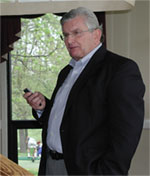By Tarre Beach, secretary, Kansas City ASBPE Chapter
 Editorial audits accurately measure a magazine's content with its mission and offer B2B editors and publishers an opportunity to compare and contrast their product with their competition, said Vern Henry, Advanstar Communications corporate editorial director.
Editorial audits accurately measure a magazine's content with its mission and offer B2B editors and publishers an opportunity to compare and contrast their product with their competition, said Vern Henry, Advanstar Communications corporate editorial director.Henry, who recently received the ASBPE Lifetime Achievement Award, said getting feedback from all the editorial, circulation, and advertising departments helps give a clearer picture of a magazine's strengths and weaknesses. Audits are a good time for a magazine staff to step back and ask questions, he said. Rather than waiting until your magazine is in trouble, it's best to conduct an audit when your magazine is succeeding and try to do one annually.

The two-time nominated Pulitzer Prize candidate and winner shared the step-by-step process with 40 attendees at a recent ASBPE Kansas City chapter meeting. After listening to his presentation, both editors and designers expressed interest in conducting an audit to improve their publication's content and visual appeal. Here's how you can conduct an audit at your magazine.
1. Develop a checklist and give it to your editorial staff a few weeks before the audit. Break down the checklist into the following sections: market research, incorporation of data, cover plans, news focus, column evaluation, and use of editorial advisory board. The goal of the checklist is to better understand the market, hot-button issues and the competitive landscape.
2. Adhere the editorial pages of a single issue on a long sheet of paper and view the magazine as a whole. Usually the most recent issue is used, but the auditor will normally look at about six consecutive issues to get a feel for style, voice and policy. At the luncheon Henry used Advanstar's Veterinary Economics as an example. He pointed out differences in type, how well the illustrations worked and where more visuals could be used. He said editors should be assured their work is not going to be torn apart in an audit, but instead scrutinized for value. As an auditor, he said he always strives to be gentle and offer insight rather than criticism.
3. Look at the pages together through a process called a walkthrough. Stories aren't closely read for accuracy or informative value, but the auditors look for other elements such as frequency of entry points, type face readability, first-glance content value, usefulness of headlines and decks and use of visuals. This process usually takes about five hours.
4. Recommend changes. Combined with the checklist and a six-issue review, Henry will pull out specific details to outline what is working and what isn't and give his recommendations in a final report. Finally, he will check to make sure the recommendations are implemented in a follow up.
Photo (top): Advanstar’s Vern Henry says editorial audits should include feedback from circulation and advertising.
Photo (bottom): Audience listens to Vern Henry’s tips.



No comments:
Post a Comment